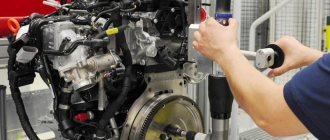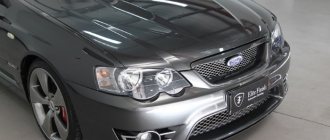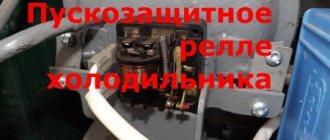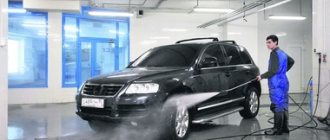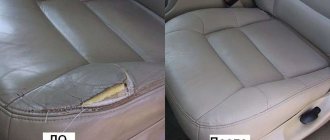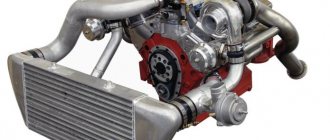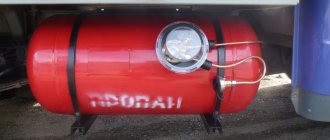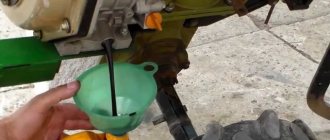Buying a thickness gauge is not a problem. You can look for the device in stock in your city, buy a used model on ad sites, or order it from an online store. And it seemed like nothing complicated: I opened the package, turned on the device, leaned it against the surface, looked at the value and compared them with different cars.
If the car body was damaged and then repaired with putty, you can easily and quickly identify these places. But if the renovation was done professionally, with minor repainting or replacement of parts, then you cannot do without the following tips that you need to know like the Lord’s Prayer.
What is a thickness gauge
A thickness gauge is a tool that helps measure the thickness of a material or layer. It allows you to set the height of rust, putty, primer or paint composition. Measurements are carried out without disturbing the structure and composition of the material. The measuring tool is used in various fields of construction and industry. First of all, it is used in mechanical engineering to control the thickness of the paint coating applied to the vehicle body. The device is also used in service centers. It is necessary to carry out a pre-sale analysis of a car in order to identify hidden defects and identify breakdowns. For example, if the vehicle was in an accident, the cracks formed were repaired with putty and painted over, then you can see the flaws using a thickness gauge tool. The tool will show that in a specific area the thickness of the layer on the body exceeds the required value. It will not only make it clear that this is where the defect has formed, but will also determine the depth of the crack. The device will allow you to fight dishonest sellers who often sell a dented car by masking the defects. The equipment is used by car painters, appraisers, and insurance agents. In the construction field, thickness gauges help to check the layer of insulating materials applied to communications.
Thickness gauge
Work principles
The amount of paint and varnish composition that the manufacturer applies to the surface of the car usually does not exceed 140 microns. Often, after straightening, parts are treated with putty, then a primer is applied. These manipulations create additional thickness, which the tool will reveal. A vehicle that has not been completely repainted has varying thicknesses of paint on the hood and doors. Sometimes the indicators of the straightened part may be downward, then it will be difficult to understand which part was changed. A difference of 100 microns becomes proof that a non-original paint layer has been applied. A discrepancy of 200 microns and above indicates the use of putty. The hand-held device has an ergonomic design. It is equipped with remote parts for calculating the display on which the result is displayed. The instrument consists of an electronic unit to which replaceable ultrasonic or electrical type transducers are connected via wires. To measure size, combined and separate-combined transducers are used. The instrument is brought to the material being studied and turned on. The principle of operation of the thickness gauge is to determine the time of double passage of ultrasonic vibrations through a body or other part from one surface to another. The results shown are indices of thickness. Before using the tool, the surface must be cleaned of dirt and dust. When rust appears, it will be scraped off. The tool is used only for metal bases. The surface to be studied must be smooth.
Operating principle of the thickness gauge
Why check paint thickness at all?
The thickness of the paint coating (LPC) determines whether the car body has been repainted or repaired after an accident. This means that it is possible to determine whether there were any accidents at all.
A car is painted in two cases:
- For cosmetic purposes - due to a scratch or minor accident.
- After a serious accident.
Not only a used car, but also a new one can be tinted. If you are not an expert, it is difficult to determine by eye whether a car is painted: with careful repairs, the coating cannot be distinguished. Therefore, you need to measure it with a thickness gauge.
You can still buy a car after cosmetic painting, for example with a repainted wing, even if the thickness gauge shows deviations from the norm. But deviations are a reason for bargaining.
Thickness gauge calibration
Calibration will be needed in a number of cases:
- the device has not been used before;
- the sample has changed;
- the instrument has been damaged.
Pay attention to: Painting alloy wheels with your own hands: choosing a material, step-by-step painting instructions
The need for settings is directly explained by the purpose of the tool. You can tell the “fate” of the body by the thickness of the paint. Vehicles are painted not only for aesthetic reasons, but also if there are scratches after an accident. In view of this, it is necessary to carry out measurements in order to distinguish a new car from a damaged one. Pre-calibration will be required for any use of the device. Car enthusiasts and craftsmen are interested in how to calibrate a thickness gauge. You cannot set up the equipment with your bare hands, only using a sample. Manufacturers often make special plates along with the device, which are the standard for measuring work. A clean metal surface shows a result of zero. The product should produce a value close to 0 due to the lack of coating. If you place a plate of known thickness on the body, the device will display this value. Otherwise, it is considered to be configured incorrectly and incorrectly. The calibration process occurs in several stages: Plates are placed on a clean surface. The thickness gauge settings are reset to factory settings. Usually click on the number “0”. Based on the interface, the scales are adjusted using the plate as a sample. Thus, calibration means comparing the thickness of the sample and the indicators that the equipment shows. An equal value should be displayed, then the setting is correct.
Thickness gauge calibration
What kind of coating do different thickness gauges work on?
First of all, you must clearly understand what capabilities your device has - what it can measure and what it cannot. In one of the previous articles, I talked about the physical principles of operation of thickness gauges. It is on these principles that the ability of devices to measure the thickness of a coating on a particular material is based.
For example, if you have a device based on:
- Based on a purely electromagnetic principle, he can only measure coatings on ferromagnetic (iron-steel alloy) housings.
- Based on the electro-eddy current principle, it will measure well the thickness of coatings on diamagnetic materials (alloys of aluminum, copper, bronze, etc.), and on ferromagnetic materials it will work with slightly less accuracy.
- Using the combined electromagnetic eddy current principle, it will be possible to measure coatings on any metals.
- Based on the echolocation-ultrasonic principle, you can measure the thickness of anything, on anything, without the functioning of the device depending on the material of the case.
That is, all devices, except ultrasonic ones, require a metal base of the coating being measured to operate. Therefore, if you need to check newfangled cars with composite-plastic bodies for damage, then you need to rent a professional echolocation device.
What to check on the car
A vehicle can have at least 5 places on its body that can be checked. It measures the roof, hood, doors, fenders. Any part is checked by five applications of the tool - on the sides and in the middle. It is necessary to examine the racks, which are an element of the body from the bottom of the glass to the roof. It's easy to understand how to use a paint thickness gauge. The tool is placed perpendicular to the surface. If installed at an angle, the indicators will show inflated numbers. Sometimes repairs are carried out not on the entire body, but on some part of it. The transition point is a stamping or the place where the body has a relief surface. If the owner is measuring a body with a relief, then you need to examine the details above and below the bulges. Otherwise, there is a possibility that the product will poke into that part of the wing that was not damaged in the accident. In addition, lower on the wing there may be a greasy layer of putty. The equipment is used not only for inspecting external parts. To exclude repair work after a traffic accident, the body is analyzed from the inside. Install paintwork on the frame. You need to open the door and check the rack. Then they lift the hood and analyze the cups and wing flange. The numbers on the instrument screen should not show 100 µm.
Pay attention to: Car varnish aerosol: main types, advantages and application technique
Aluminum parts
Before fixing the thickness of the coating, you need to find out whether the model has aluminum parts. For example, in Audi, Range Rover, BMW, doors and front fenders are made of aluminum. To measure coatings on elements, you will need a thickness gauge, which is used for metal. This is the Etari ET 555 model. When purchasing a tool, you need to keep this nuance in mind. No specific settings are needed. The transition between ferrous and non-ferrous metal is usually carried out automatically. The type of material – steel or aluminum – is indicated on the instrument display. Factory indicators for aluminum products differ from steel ones and decrease by 1.5-2 times. If there should be a part made of aluminum on the car, but the tool detects it as steel, this means that the product was replaced with a fake, non-original one. This is evidence that the car has been in an accident.
Checking an aluminum part
Plastic parts
The device does not function on plastic products. In modern cars, bumpers, door handles, exterior mirror covers and some other spare parts are made from plastic. It is recommended that you familiarize yourself with the features of a particular vehicle before checking it with a thickness gauge. It's better to watch a few videos on the YouTube channel. If the thickness gauge is tested on a dirty machine, the device may be damaged or break. It will also show incorrect values. Using a tool on the body will damage the device and the paint of the car. Before measuring, the car must be washed and cleaned. This will prevent damage to the measuring device, its incorrect operation, and will also allow you to find defects.
Please note: Automotive paint drying time
Plastic parts
The thickness gauge does not work on plastic parts. Modern cars have bumpers, door handles, exterior mirror housings, and sometimes other parts made of plastic. For example, the Peugeot 408 has plastic front fenders.
It is better to study the features of a specific car model before inspection. To do this, just watch 5-10 videos with an inspection of the car you need on YouTube.
A thickness gauge on a dirty car may fail or break.
It is wrong to use a thickness gauge on a dirty car. Firstly, the readings may be incorrect. Secondly, using a thickness gauge on a dirty body spoils both the device and the car’s paint.
Is it possible to fool the device?
Dishonest mechanics and salesmen have learned to use tension gauges to their advantage. Often, instead of painting a body element, dealers simply replace it with a new one, painted at the factory. The thickness gauge can show the level of paintwork and the presence of repaints, but does not indicate whether the part has been replaced. This is what sellers who want to hide the fact of an accident take advantage of.
The thickness gauge itself has an approved error level, which depends on the specific model and the quality of its assembly. Specialists may refer to inaccuracy if they see that the buyer does not understand it.
It is recommended to carry out the verification procedure in the presence of a person experienced in using a thickness gauge.
Measurement procedure
The direct measurement procedure is not particularly difficult - any driver can handle it.
Here you should take into account the differences in turning on devices for different models: trigger and some pressure devices of an outdated type must be turned on without touching the sensor to the surface being examined, while modern devices automatically turn on when the sensor comes into contact with something solid.
Attention! Do not point the switched-on sensor into a person’s eyes at close range!
Everything else is pretty simple:
- Press the turned-on thickness gauge against the surface being examined, and it will display the measured readings on the screen. In trigger models, to initiate measurement you need to press and release the trigger; in push models everything happens automatically. Keep in mind that the device must be held firmly and level so that the sensor comes into contact with the enamel without distortion.
- You can examine the surface pointwise or in continuous measurement mode: without releasing the trigger or simply continuing to move the pressure device along the paintwork in the desired areas - the readings will change.
- But to derive average thickness indicators for a car, point measurements are needed: each segment is examined separately.
- The elements are conventionally divided into 5 parts (4 in the corners and 1 in the middle). Of course, you can take more measurement points, especially if there are already some suspicions in a certain area.
- For each point, 3-5 measurements are taken, which are recorded on paper or a ready-made printed diagram of the car.
- Carry out each point measurement not in the same place, but in a radius of about 10-20 cm around the selected center - this will achieve greater average accuracy.
- After this, for each measurement, the arithmetic mean is calculated - the sum of the readings of all measurements of a point, divided by the number of measurements of this point (elementary school arithmetic).
- As a result, you will get 5 arithmetic average readings for each body element, by which you can judge the degree of discrepancy between the thickness and the factory parameters of local areas (roof, wings, doors, etc.).
- From these 5 indicators, you can easily calculate the arithmetic average of the thickness of the paintwork for each segment, and based on this, make a calculation for the entire machine.
And now the same thing, only more clearly:
How to use a thickness gauge first part:
What thickness values are considered a discrepancy with the factory ones?
It is not difficult to determine, using the thickness gauge readings, non-factory paint, much less puttying areas, if you know all the initial data.
The practice of examining used cars shows that usually in cases of repainting/touching up, the instrument values are 2 or 3 times higher than the standard factory ones.
In fact, we can say this: if there is a discrepancy of a hundred microns or more, then this is guaranteed not to be the original coating. Moreover, a discrepancy exceeding 160 microns indicates a putty layer.
An ordinary additional layer of paintwork adds approximately an extra 100 microns to the existing one. This means that if the overall reading is 180-260 microns, then this indicates overpainting/touching up. And if it’s higher, then it’s already painting with putty. The thickness of putty can sometimes have not micro, but macro values, which thickness gauges are not able to display on the screen due to being off scale.
How a car painter works so you don't notice anything
You also need to take into account the possibility of all sorts of tricks by auto body mechanics. For example, they can specifically reduce the factory thickness of the paintwork with abrasive polishes before painting. Because of this, in case of inept operation, the thickness gauge shows values less than the factory ones (for example, 80-90 microns from the original 110-120).
If you want to learn more details about working with a thickness gauge, then watch this video, where an experienced dealer reveals the features and secrets of such a process using the example of examining a popular model of a domestic car:
What coatings do thickness gauges measure?
Unlike the body base, for household thickness gauges the coating to be measured can be made of almost any solid material. What could this be, for example?
- Different types of paint and varnish coating;
- All kinds of primers;
- Putty layers;
- Layers of rust;
- Plastic coverings;
- Ceramic and other layers on metal.
- The coating being measured must be dielectric;
- It should have a smooth outer surface.
That is, to be able to measure with instruments based on magnetism, and all household thickness gauges are exactly like this, you need to have a metal base and a smooth dielectric coating - most car bodies today meet these conditions, although in the future, perhaps, car bodies will be made primarily from non-metallic materials.
Of course, you also need to take into account the relationship between the type of your device and the properties of the body metal. However, this applies more to outdated devices - almost all modern thickness gauges can work on any metal base, including budget models like the All-Sun EM227.


